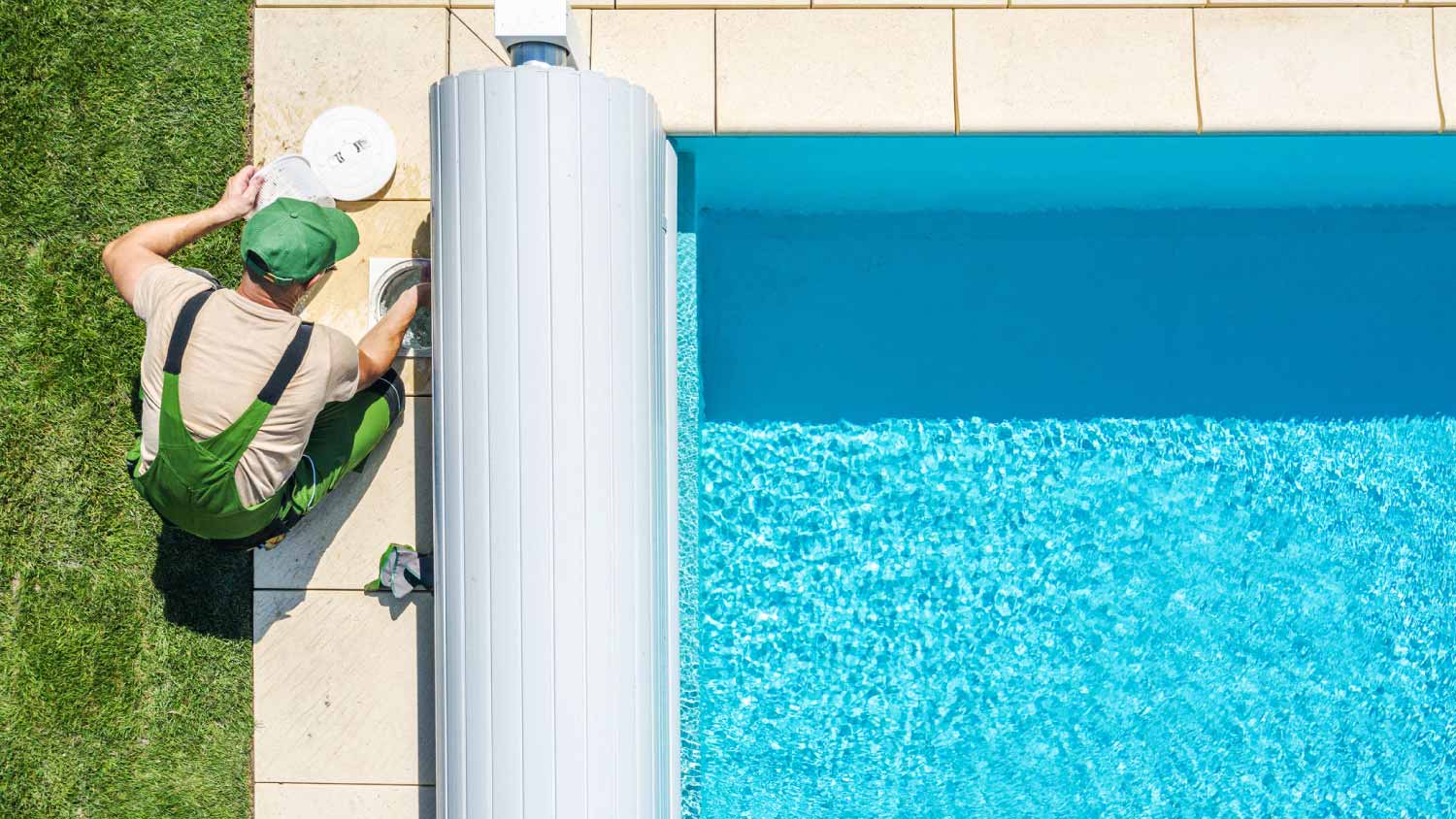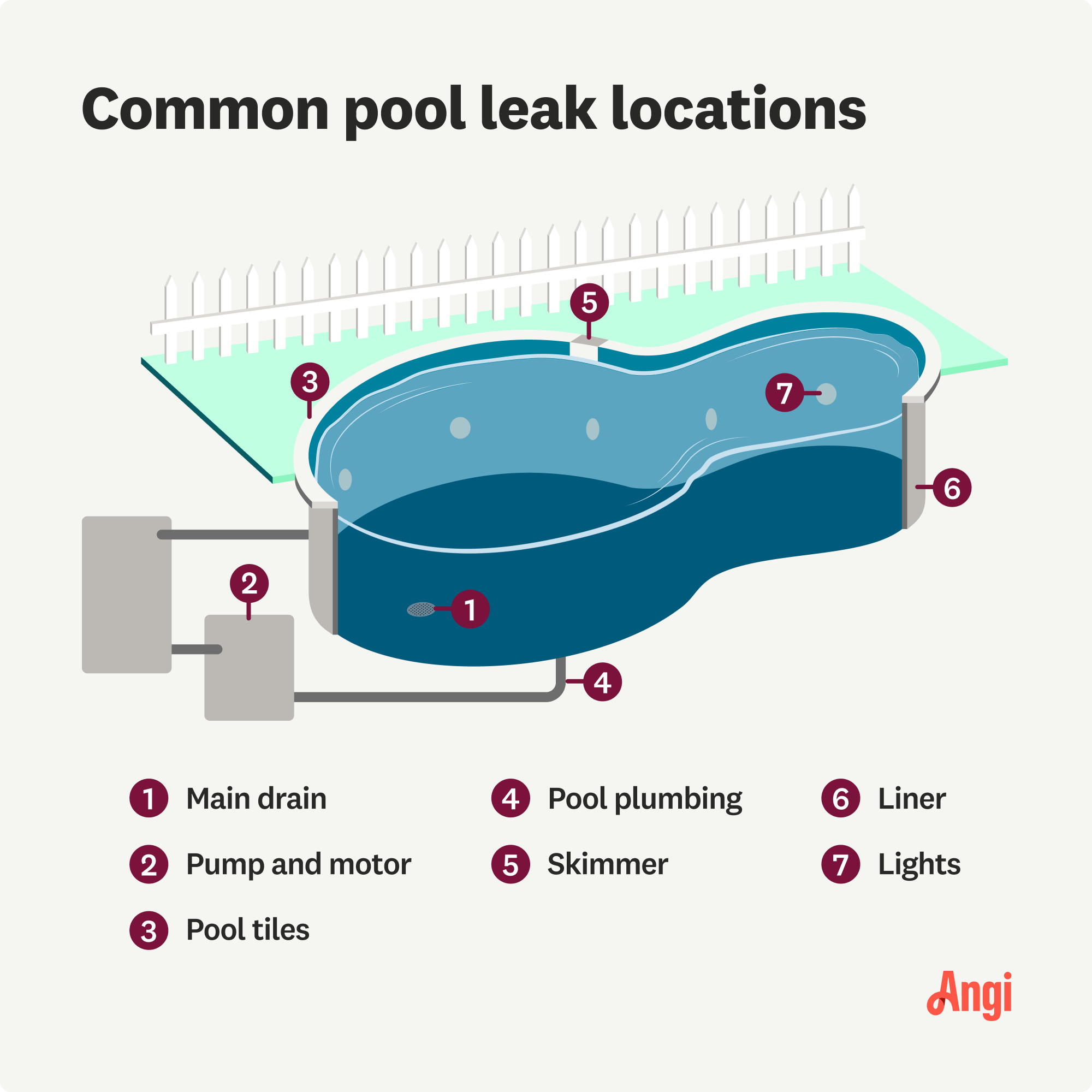
If you’ve been considering installing a new pool in the Buckeye State, this guide will help you understand inground pool costs in Columbus.
Find your pool leak and get it fixed so you can get back in the swim of things


Pools are a lot of fun until you’re left wondering why your water level has dropped. Learning how to find a leak in a pool can help you assess or repair the problem before it gets worse. Like any other problem around the house, it’s best to identify and fix issues as soon as possible. Get started right away and detect a swimming pool leak in four easy steps.

Looking for a pool leak might sound like a straightforward task, but you should keep some important pool safety considerations in mind. For one, avoid accidental electrocution by staying away from wet electrical wires.
Secondly, be careful not to fall into the pool while doing your inspections. Also, only dive underwater to look for the leak if you have the swimming and diving skills to do so safely.
If you’re sure you can take all of the necessary safety precautions, familiarize yourself with the potential sources of your pool leak, which may include:
Accessories
Equipment
Fittings
Plumbing
Shell
Skimmer
Underwater pool lights

Another important thing to note is that you shouldn’t drain your pool when you discover a leak, even if it seems logical at first. You need water in the pool to figure out what’s going on.
In case you’re wondering if a pool has a leak at a home you’re about to buy, it’s a good idea to call a pro and get a pool inspection to avoid any unwanted surprises down the road.
A pool will lose between 1/4 to 1/2 inch of water per day from normal evaporation or usage. If you find your pool is losing more than that, contact a pool specialist who can use leak detection equipment to diagnose the issue.
Although not all swimming pool leaks are easily detectable by sight, a visual inspection is a good place to start. For example, you may have noticed your pool water levels are dropping more than a 1/2 inch a day.
It can help to do a quick pool cleaning so you can see everything in and around your pool. Start by walking around your pool, pool deck, and yard. Keep an eye out for puddles of water in the grass, cracked pool tiles, and cracked concrete. You may also notice cracks in the vinyl or plaster or find that your skimmer is separating from your concrete.
Next, turn off the power to your pool equipment at the breaker, and head to your equipment pad to check for leaks. Check the filter, valve, pump, and heater for leaks, and see if the ground is wet. Make sure there’s no trickling water when the pump is off. If you have a vinyl-lined pool, do a thorough check of the liner. If you notice sinkholes, tears, or separation between the fittings, you may have a leak.
Moreover, the older your liner, the more likely it is to suffer from tiny holes. It’s possible to temporarily fix holes smaller than 1 inch with a patch or sealant kit. If you feel up for the DIY job, you can patch a pool liner. But if the repair is significant, you should hire a pro to avoid future damage. The average pool liner replacement costs $2,500.
If you suspect you have a leak, move forward with the bucket test. The bucket test helps you know if you’re losing pool water due to a leak or evaporation.
Before starting, turn off your pump. Fill a bucket with pool water, and mark the water level with duct tape. Next, mark the pool’s water level with duct tape. Wait 24 to 48 hours, and then check the water levels.
If the water level changes are similar in your bucket and your pool, you’re dealing with evaporation. However, if the water levels are significantly different—meaning you’re losing water faster than it’s evaporating—it’s likely a leak.
You can repeat the bucket test with the pool pump running. If you notice that the water levels are lower during this second test, then you may have a leak in your plumbing or filtration system.
Once the bucket test confirms that there’s a leak in your pool, it’s time to figure out where the leak is coming from. If you are still unsure of potential leak locations, the best places to check are seams, cracks, fittings, and the skimmer.
You can use red, yellow, or blue pool leak detection dyes or food dyes if you have them handy in your pantry. Red is the most commonly used dye color. However, yellow dye works well in dark-colored pools, and blue dye is best for light-colored pools.
Before you get started, turn off the pool pump and all water features. Next, prepare a syringe with the dye and slowly release a small amount next to the suspected leak location. If there’s a leak nearby, the dye will be drawn toward the location of the leak. When you find a leak, whether it’s above the water or underwater, mark it with waterproof tape. That way, you can easily come back to it when you’re ready to apply the pool putty or patch.
You may also need to grab your goggles and dive into your pool to find the source of the leak. If you notice your dye moving through your main drain, unscrew the grate to locate the precise location of the leak.
DIY pool putty or patches are only temporary fixes. If properly installed, patches can work for a year or longer, but you’ll need to hire a professional pool repair service near you to help you with a permanent fix.
You may be able to fix leaks in your pool fittings using silicone. Potential leak locations include your underwater lights, jets, or faceplate. A temporary patch can stop a skimmer leak, but you’ll most likely need to replace the skimmer for a permanent solution. If your leak is due to plumbing problems, aboveground or underground, you should skip any DIY attempts and call a pro.
Your pool could be losing water due to normal evaporation. Without a pool cover, pools lose ¼ inches of water each day during the summer. Installing a pool enclosure and cover can help prevent this.
If your pool water level drops significantly—more than would normally evaporate—it could be a sign that you have a leak. Other signs that you should test for a leak include:
High water bills: If your pool has a leak, you’ll be filling it more often, which can lead to high water bills. You may not notice that you’re filling the pool more frequently if you have a system set up to automatically fill the pool, so keep an eye on how much water you’re using.
Puddles or moisture around the pool: Pool leaks can cause water to seep into the surrounding yard or onto the pool deck. If you notice puddles forming or extra moisture where it doesn’t normally occur, it might be a sign that you have a pool leak.
Difficulty maintaining chemical levels: If you’re struggling to keep the pool chemistry at optimal levels, it could be because the pool is losing water due to a leak.
Visible damage: You might notice a tear in the pool lining or cracks in the structure. This is a sure sign that your pool needs immediate attention.
If you suspect you have a pool leak based on any of these signs, it’s important to test for leaks or call a pro.
Hiring a professional to detect a pool leak costs between $100 and $1,000, with an average price tag of $300. But, it's likely you can save on those costs and find the leak in your pool on your own, as long as you can follow safety precautions. And if you’re a handy DIYer, you may even be able to fix the problem temporarily. However, you’ll eventually have to call in a pro to help you with a permanent solution.
And while you may catch yourself procrastinating on finding a long-term solution, it’s a good idea to take care of leaks as soon as possible. The cost of repairing a pool may increase as the damage worsens.
Raven and crew does absolutely fantastic job. They are very professional if any concerns were to occur with any of her work she always took responsibility and finished out with a great job. I have worked with her business for a year and have always been satisfied. Very trusted business and...
I had Ace Fireplace Services install custom chimney caps for my home, and the results are stunning. They fit like a glove and have added a touch of sophistication to my chimney. I can't recommend their services enough.
Precision and professionalism define Custom Paint Jobs LLC. We couldnt be happier.
Very professional and efficient with work. Answered each question I had with great knowledge and an informative response. Will be working with them again.
I first met Ilia when windows were installed on my new back porch. He was extremely conscientious about getting the job done right and it was. Now I ve had all the windows of two levels of my house completed by him.....ON TIME, ON BUDGET, TO MY TOTAL SATISFACTION. I'm a happy customer.
Great tree company, very professional and honest. Glad we found them, they had the best pricing
AFS was excellent from start to finish. Jess, the sales associate, was fantastic...very knowledgeable and very professional. The installation crew was excellent. I couldn't be more pleased with the process. Best of all, my new floor looks fantastic!
Maple Tree Service should serve as a mentor for other business! Customer service was superior and beyond expectation. Response to request was prompt. The representative was very courteous and proud of the company. Quote was given during initial visit and work date established. A follow up...
Eugene returned my call within minutes and was able to complete the job within a couple of days. Friendly and professional, and I feel his prices are reasonable.
We used Unique Hardwood Floor LLC three years ago to work on the floors of a 70 year old home that needed a great deal of work. Some floors needed repairs, some were replaced and others just needed to be refinished. It was a complicated job as they needed to blend the old and the new to...
From average costs to expert advice, get all the answers you need to get your job done.

If you’ve been considering installing a new pool in the Buckeye State, this guide will help you understand inground pool costs in Columbus.

Fiberglass pools are a solid choice. If you are looking into installing one at home, read this guide to learn all the ins and outs of fiberglass pool costs.

The cost of pool liner replacement in Columbus depends on the size and shape of your pool, as well as the liner material and type. Here’s how the costs break down.

Dreaming of getting in those daily laps without tearing up your backyard? Here’s what to know about endless pool costs so you can plan your project.

Baking soda is a budget-friendly way to tackle DIY pool maintenance. Our guide explains how to add baking soda to a pool.

Learning how to drain a pool is just as important as all the other upkeep tips you've gathered along the way. Here's a step-by-step DIY guide.